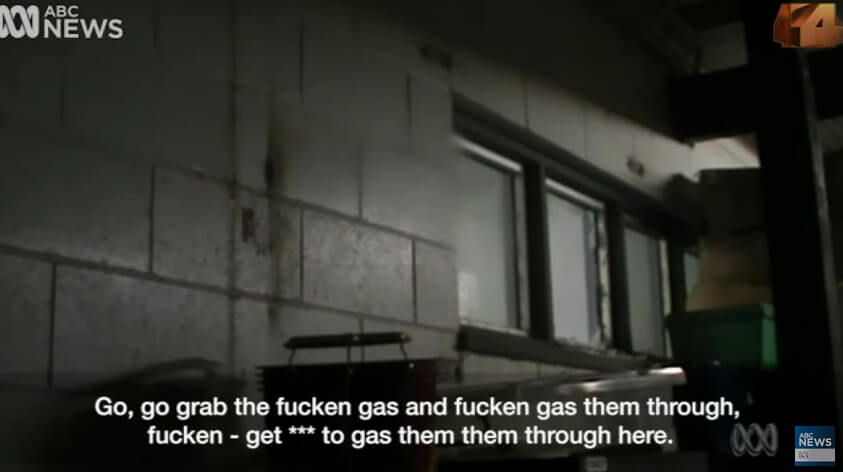
Last week, shocking footage depicting security personnel in a Northern Territory (NT) juvenile detention center teargasing and torturing indigenous detainees made headline news in Australia. In contrast to the uproar it has now engendered, this incident was actually first reported two years ago and attracted little outcry from a largely disinterested Australian public. Despite the tireless efforts of indigenous and social justice advocates, the vast majority of Australians remain reluctant to address the elephant in the room: that the use of mass incarceration among indigenous people in Australia is a tool of ongoing colonization.
It’s been 25 years since the Royal Commission into Aboriginal Deaths in Custody made 339 recommendations on how the government could finally take action on the systematic discrimination and grave maltreatment of Aboriginal and Torres Strait Islander people in the Australian justice system. One of the foremost recommendations was that incarceration should be used as a last resort.
Today, this recommendation has been ignored wholesale as Indigenous Australians continue to be grossly overrepresented in prisons. Overall, indigenous incarceration has increased by 88 percent since 2004, while non-indigenous incarceration increased by just 28 percent. According to the ABS in June 2015, Aboriginal and Torres Strait Islander people made up 27 percent of prisoners nation wide, while comprising just 2 percent of the total population. This gives aboriginal people an incarceration rate that is 18 times higher than non-indigenous Australians. Indigenous incarceration figures also increase dramatically among youth, where 24 percent of all indigenous prisoners are under the age of 24, compared with 14 percent of non-indigenous youth.
Commenting on the lack of positive progress, aboriginal activist and Wiradjuri elder Ray Jackson laments, “There’s something totally wrong with a system that comes up with those numbers. We’re on a treadmill to nowhere at this point in time.”
Rightly so, commentators and lawyers have been quick to point out that the gassing, hooding, arbitrary stripping and other forms of verbal and physical abuse of aboriginal youth that have surfaced at the NT’s Don Dale Youth Detention Centre amount to torture. In response to public pressure, the government is set to launch a federal inquiry into the matter. Given widespread examples of torture occurring outside of the Northern Territory, too, the buck shouldn’t stop at Don Dale; nor should it stop at labeling it torture. If we want to get serious about treating the root causes of the over-representation and abuse, it is imperative that we view these issues within the long history of mass incarceration as an abhorrent tool of colonization, suppression and control in Australia.
Since the invasion of European settlers in 1788, colonization in Australia has been about controlling a pre-existing indigenous population through varying forms of violence, manipulation and torture. Today, the justice system remains a key facilitator of all three of these, yet studies have inadequately considered the centrality of colonialism to the origins, nature, scope, and – importantly – widespread legitimization of discriminatory carceral power in Australia.
During the peak of colonial conquest in Australia, the torture and incarceration of aboriginal peoples was commonplace. Given that this history lives on in today’s increasing aboriginal incarceration rates, it has been suggested that, for some aboriginal communities, prison has simply become “part of their domain”, a “normal phase…of one’s life-course”.
Ultimately, this over-representation of indigenous people has been caused by – and is reflective of – the colonial imperative requiring the marginalization of indigenous people. Instead of dealing with this foundational marginalization issue, the government has diverted attention towards the indigenization of the justice system to make it as effective as possible in processing indigenous offenders. In this way, we’re still working within a broke system, rather than venturing out of it in any meaningful way.
Contributing to this marginalization and, therefore, mass incarceration, is the obvious lack of informed social policy in indigenous communities. In his 2007 analysis, Jonathan Simon wrote about how, in the US, criminalization and imprisonment are actually used as tools of social policy, resulting in ‘governing through crime’. In Australia, this goes one step further. Beyond being a ‘tool’ of social policy, the vast lack of appropriate government policies on health, education, housing, mental health and more in indigenous communities that take into account the continuing reality of colonialism, in conjunction with high incarceration rates, indicates that the indigenous incarceration is essentially being used as an alternative to effective social policy all together.
This is particularly evident in Western Australia, for example, where the state government plans to forcibly close 100 to 150 remote aboriginal communities to relieve itself of the financial burden. This unwillingness to allow for the free pursuit of collective development reeks of a lingering colonial obsession with controlling and containing indigenous people at the least possible cost.
Pointing out how little we’ve learnt since the Stolen Generation era, Amnesty International has warned that we risk losing another entire generation of indigenous youth if their arbitrary incarceration continues unabated. As Salil Shetty, Amnesty International secretary-general, articulated back in June 2015, it is critical that “Australian governments get smarter about this, and fast”. Transformative and sustainable social policy reform is integral to this. Clearly, it’s time to progress the national conversation beyond Don Dale, and far beyond the language of isolated inquiries into incidents of torture. Instead, it’s time to start discussing how the tools and tactics of colonialism are still very much at work in modern day Australia.
Leila Nasr is a current MSc Human Rights candidate at the London School of Economics and Political Science (LSE). She is also the Lead Editor of the LSE Human Rights blog, and has a keen interest in issues of indigeneity and colonialism.

Indigenous Peoples are putting their bodies on the line and it's our responsibility to make sure you know why. That takes time, expertise and resources - and we're up against a constant tide of misinformation and distorted coverage. By supporting IC you're empowering the kind of journalism we need, at the moment we need it most.